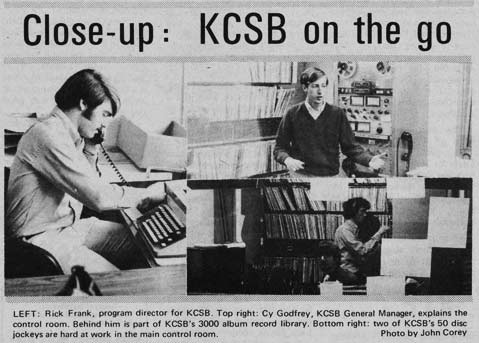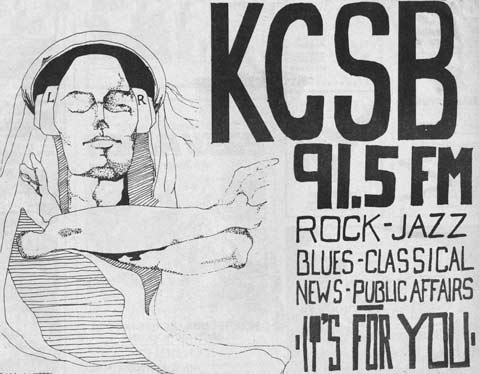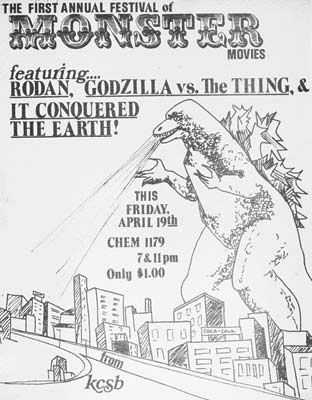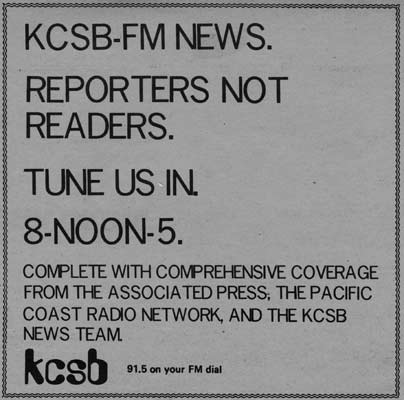Onward and Outward Into the Seventies
Brief History of KCSB, Part III

The 1960s saw KCSB evolve from a scrappy, dorm-based carrier-current operation to an ambitious campus broadcaster to a Class D-licensed radio station putting out ten watts of music, news, and entertainment to UCSB and its surroundings. When that decade went into its grim crash-landing, exemplified locally by the KCSB-covered Isla Vista riots of 1970, things must have looked bleak.
But all records indicate that the station seized the rest of the 1970s as one big opportunity to expand, making longer strides than ever toward becoming the distinctive yet protean community media entity it is today. As the operation hit maturity and became technologically competitive with established broadcast media, the question shifted from “How can KCSB become a real station?” to “What should KCSB be, anyway?”
In April 1970, the very same month it endured a three-hour shutdown at the hands of the law, KCSB stepped up its power 18-fold by obtaining a 180-watt transmitter. Equipped with the first directional FM antenna ever put into service by a radio station, the transmitter was moved from the roof of the venerable San Miguel dorm to the Santa Ynez mountains’ 4200-foot-high “Broadcast Peak.” Ten miles northeast of Santa Barbara, the site hosts many county broadcasters’ gear, including that of KEYT-TV. This new arrangement greatly expanded KCSB’s range, making new listeners out of Santa Marians to the north and Venturans to the south, and opening up a potential audience of over 150,000, surely an unthinkable number back in the Radio Navajo days.

With 50 licensed broadcasters in its control room putting in on-air shifts 24 hours a day, seven days a week, all year round, KCSB turned in a newsier direction. In interviews at the time, the series of general managers inaugurated in the early 70s–and de-inaugurated, due to the position’s one-year maximum term–emphasized their desire for tighter integration with the local community, not just the university. After the Santa Barbara Grand Jury accused KCSB of editorializing and biasing their news coverage, the managers also began to talk, unsurprisingly, about a need for objectivity as well.
With or without a slant, KCSB implemented daily morning, afternoon, and evening local reports, boosting particularly its coverage of Isla Vista and Santa Barbara. Caught up in this building momentum, the station’s sports department was revitalized after a long dormancy, offering live broadcasts of events all the way from high-profile basketball games to pushcart races on the dorm lawns. Keeping the national and international fronts covered, KCSB even became an ABC News affiliate. All of these efforts bore fruit in 1973, when the California Intercollegiate Press Association named KCSB the best news station on a California college campus.

This effervescence spread well beyond the domains of news and sports. After a stretch of weak presence, classical music returned to the schedule with a vengeance, in three-hour blocks each morning. Broadcasts from the Metropolitan Opera aired every Saturday. An entire French-language program would soon debut. KCSB hosted its first–and, from all available records, last–Annual Festival of Monster Movies as a 1974 fundraiser, screening Rodan, Godzilla vs. the Thing, and Frank Zappa’s personal favorite “worst movie ever made,” It Conquered the Earth! Stereo broadcasting, perpetually hoped for and perennially proposed, finally became a reality on May 14, 1975. (The question of whether anyone pushed for the full quadraphonic listening experience remains unanswered. But it was the 70s; someone had to have.)

As this diversification and development continued, opinion pieces began appearing in UCSB’s Daily Nexus, all with the same lament: Must KCSB be such a hodgepodge? Media surveys revealed about two-thirds of the university’s student body “never” listened to the station. The Nexus ranked KCSB as the “least used” campus information source. Letters appeared bemoaning the DJs’ penchant for “obscure blues and esoteric jazz.” The lack of live coverage of certain politically newsworthy campus events spawned continuous complaints–a line of complaint that seems to have taken root when KCSB reported on October 1968’s North Hall takeover only after the fact.
Thus an argument was spawned that, despite rises and falls in its intensity, continues to this day: What is KCSB’s proper mission? Is it to educate? To entertain? To provide music? To promote local culture? To serve the student body? To serve the community? Is it some mix of all of these?
But by the mid-70s, the pendulum had swung decisively toward the community-service model. As the station continued to grow in power and importance over the latter half of the decade, both the voices defending and the voices questioning that stance would, alas, only get louder and more opinionated.



